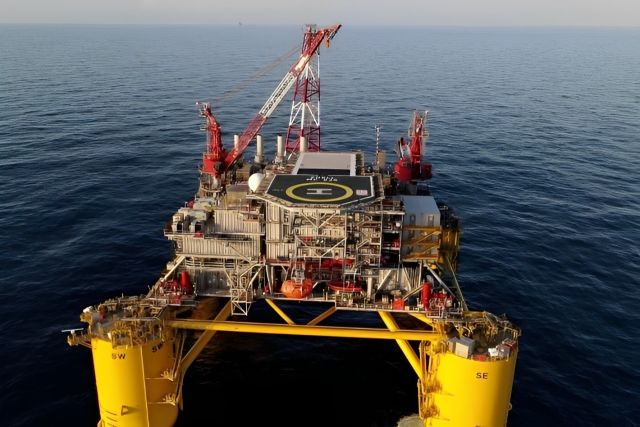
Developments like Whale (pictured), Appomattox, Vito and Perdido were first identified as prospects using wide azimuth towed streamer data. (Source: Shell)
Geophysics and seismic data, a value driver for the oil and gas industry since the 1930s, are at their heart what Shell’s Bill Langin sees as a contact sport.
Speaking at the 2024 IMAGE conference, Langin, vice president of exploration for Shell, said that many of the company’s achievements in the Gulf of Mexico (GoM) were born from advice given to him by geoscience pioneer Jack E. Oliver.
“Geophysics can be a contact sport… it’s as competitive as any football game you’ve ever played in,” Oliver once told Langin. “You have to treat discovery like a competitive sport and have that mindset that you if want to win, you’re ultimately going to [have to] be outstanding in this field.”
Langin said the advice has guided him over more than 20 years in the industry, allowing him to play a part in some of Shell’s biggest discoveries, especially offshore Gulf of Mexico.
Shell now finds itself on the “cusp of another monumental advancement in seismic acquisition and processing technology, as you see companies being able to make exploration-scale node based acquisition affordable, fast and—in the not-so-distant future—competitive with streamer data and the advantages of this acquisition methodology restoration,” Langin said.
Unlocking deepwater: a brief history
The advent of computer-based processing in 1960s and 1970s unlocked the first wave of onshore discoveries, he said. The powerful computers were eventually used offshore for amplitude supported prospects, enabling more modeling and full 3D seismic processing interpretation for these discoveries.

“With each of these innovations comes another uptick in the creaming curve because we can see the place, we can understand the tracks, we can sharp shoot the risk elements and we can turn that into valuable discovery wealth that ultimately become valuable projects,” Langin said.
Each advance in seismic acquisition imaging and interpretation techniques directly correlated with big increases in the discovered volume creaming curve graph, which shows the relationship between the cumulative discovered volumes of hydrocarbons and the number of wells drilled or time, Langin said.
That wave of discovery, coupled with enhancements such as 3D visualization rooms, eventually led to an increase in imaging—and consequentially, more discovered volumes of hydrocarbons in the Gulf.
“If you go ahead and plot the early shelf discoveries, you can see the uptick when you get to a bright spot [a high amplitude anomaly in seismic data that can indicate the presence of hydrocarbons] and AVO [Amplitude versus Offset]-based things,” he said. “When we get to 3D you see another uptick in the creaming curve and then as you get to pre-stack depth migration in a complex area like Gulf of Mexico, you see another uptick.”
Shell’s bright spot technology, which was first used offshore in the 1970s, helped them predict and map other pays, leading to discoveries of 150 MMboe at Eugene Island Block 331 and 250 MMboe discovery at South Marsh Island 130 Field.
In the 1980s, bright spot technology helped Shell discover 1.5 Bboe to 2 Bboe on the Gulf of Mexico shelf and, in the 1990s, played a key factor in Shell’s entry into deepwater GoM and the discovery of 4 Bboe.
“Ultimately those discoveries have turned into projects throughout time for Shell and for many others,” Langin said. “The trend in technology is accompanied by a trend in deeper and deeper water, which is accompanied by our partners in the engineering space being able to come up with cost effective facility designs that actually enable these discoveries to be produced and ultimately monetized.”
Shell’s asset base is built on that legacy of cyber innovation delivery in discoveries, with early amplitude supported prospects, which resulted in full-fledged GoM development of Auger, Enchilada, Salsa, Mars and Ursa.
However, in the mid-2000s, Shell experienced issues with their amplitude portfolio and struggled in the first few subsalt licensing wells it drilled, Langin said.
‘Ruthless collaboration’
“We had heard that BP was doing well with the new acquisition technique, wide azimuth towed streamer, with some of their developments in Atlantis and Thunder Force and getting much better data…So we pulled the team together and we said, ‘Let’s figure out how to do this over with one of our prospects.’ Over about to two years, we worked on what would it take to actually make cost effective wide azimuth towed streamer for exploration prospects and ultimately piloted a prospect called Friesian that we tied back to” its Holstein Field unit.
Now, Shell’s deepwater portfolio consists of developments including Appomattox, Vito and Perdido, with the Whale development set to come online later this year. The projects are not only the result of Shell’s many advances in geophysics, but transitioning from the “ruthless competition amongst the many, many operators in the Gulf of Mexico to ruthless collaboration and leveraging each other’s strengths,” Langin said.
Aligning with other companies and operators, as well as partners outside of the operating base and technology and geoscience services has helped Shell transform the GoM, Langin said. He hopes to see more intercompany and intracompany collaboration offshore.
“I do think there’s still more room for cross company collaboration and recognizing who’s good at what, because the more companies having success in the Gulf of Mexico, the better off we all are,” Langin said.
The more that companies are active, the better supply chain, which leads to a larger draw for lease sales. Ultimately, that bring in more invested capital, he said, and more opportunities.
Recommended Reading
Trump Administration to Open More Alaska Acres for Oil, Gas Drilling
2025-03-20 - U.S. Interior Secretary Doug Burgum said the agency plans to reopen the 82% of Alaska's National Petroleum Reserve that is available for leasing for development.
Halliburton Sees Strong Adoption of New Oilfield Tech Offerings
2025-01-22 - Halliburton Co.’s Zeus e-fracs, Octiv auto-fracs and the Sensori monitoring platform are setting the stage for long-term growth, CEO Jeff Miller says.
NatGas Positioned in a ‘Goldilocks’ Zone to Power Data Centers
2025-03-26 - On-site power generation near natural gas production is the tech sector's ‘just right’ Goldilocks solution for immediate power needs.
Energy Technology Startups Save Methane to Save Money
2025-03-28 - Startups are finding ways to curb methane emissions while increasing efficiency—and profits.
E&P Highlights: March 3, 2025
2025-03-03 - Here’s a roundup of the latest E&P headlines, from planned Kolibri wells in Oklahoma to a discovery in the Barents Sea.
Comments
Add new comment
This conversation is moderated according to Hart Energy community rules. Please read the rules before joining the discussion. If you’re experiencing any technical problems, please contact our customer care team.




